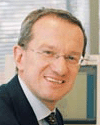Pioneer business model applied to new synergies

Lombardo: activities must be integrated
Pioneer Investments is taking full advantage of its new acquisition, German bank HVB, by targeting Eastern Europe. But its integrated model is at odds with current the multi-boutique trend, writes Elisa Trovato
A year after announcing the takeover of Germany’s HypoVereinsbank (HVB), Unicredito Italiano is making steady progress with the integration of the German bank’s asset management divisions with its own funds arm, Pioneer Investments. In July, the Italian group finalised the takeover of Activest, the German asset management arm of HVB. The full merger between the two banking groups, which will include reviewing and rationalising fund ranges, is expected to play out for the whole of next year. It will eventually leave Pioneer running total assets estimated at more than ?280bn. “Synergies at the asset management level were one of main reasons for the merger between the two banks,” said Giordano Lombardo, deputy chief executive officer at Pioneer Global Asset Management. The idea is to employ the same business model for all asset management activities of the new group united under the Pioneer brand. “Our business model mandates all investment activities to be completely integrated, although not necessarily carried out in one place. There will be the same investment process and one global chief investment officer. Distribution activities are to be organised at local level.” This model contrasts with the currently fashionable multi-boutique model employed by international companies, which says that manufacturing activities also need to be decentralised. Following the acquistion of both Activest in Germany and Capitalinvest in Austria, the main asset management companies of the HVB group, their names will be changed to Pioneer Investments and will adopt the same investment approach as their new parent company, said Mr Lombardo. Boston and Dublin will continue to be the global investment centres, while New York and London will remain the centres for alternative investments. “Some investment activities will carry on to take place at local branches, either to serve institutional clients or because they are ‘excellence centres,’” said Mr Lombardo. “For example, Activest has a very strong total return product and we will keep on running it.” According to the same philosophy, it makes much more sense to manufacture US equities from Boston rather than Milan, he said. Reshaped focus The merger with HVB, adding more than ?90bn in managed assets, has however reshaped Pioneer’s focus of its distribution strategy in Europe. A new emphasis will be placed on Germany. “In Germany, we have moved from being a small foreign player to the fifth largest player in terms of assets and the 2nd in terms of growth [after DWS],” said Mr Lombardo. In Austria, Pioneer will be the second player in terms of assets. HVB’s network will generate enormous distribution opportunities for Pioneer Investments in Eastern Europe too. “The other big advantage,” said Mr Lombardo. “Is that HVB group have a presence practically in all Eastern European countries where we are not. That is where the future growth is.” In the first half of 2006, Pioneer Investments gathered ?2.5bn in assets, coming mainly from the US and, in Europe, from Spain, Germany, Switzerland and France. All the assets that Pioneer runs outside Italy are distributed through third parties, via funds of funds or white-labelling sub-advisory, said Mr Lombardo. In Italy, however, only ?3.5bn out of the ?106bn total Italian assets are distributed through third-parties. “Italian banks see us as competitors. Given the same conditions, it is more difficult to enter a third-party network, in comparison to an American company,” said Mr Lombardo. HVB’s asset management companies recorded subscriptions of ?2.1bn during the first six months, and non-captive distribution also accounts for a considerable percentage. “Our objective is to increase distribution through third-parties around the world and favour this process by providing advisory and asset allocation services,” said Mr Lombardo. Unicredito’s culture of growing by mergers and acquisitions started in 2000, when the international Italian banking group acquired the Pioneer in Boston. This move favoured the growth of Pioneer’s relationships with global platforms, which are often US headquartered. In the past few years, the acquisitions of small, “distressed” regional banks in the US also contributed to Pioneer’s expansion in America, where the company currently manages around $70bn (?55bn). “As we decided to keep the same investment process and not to adopt the multi-boutique model, the integration was very hard in the beginning. But now it is easier to acquire new companies, because we only have to plug the new ‘union’ into our investment activities, which are already integrated at global level,” said Mr Lombardo.




